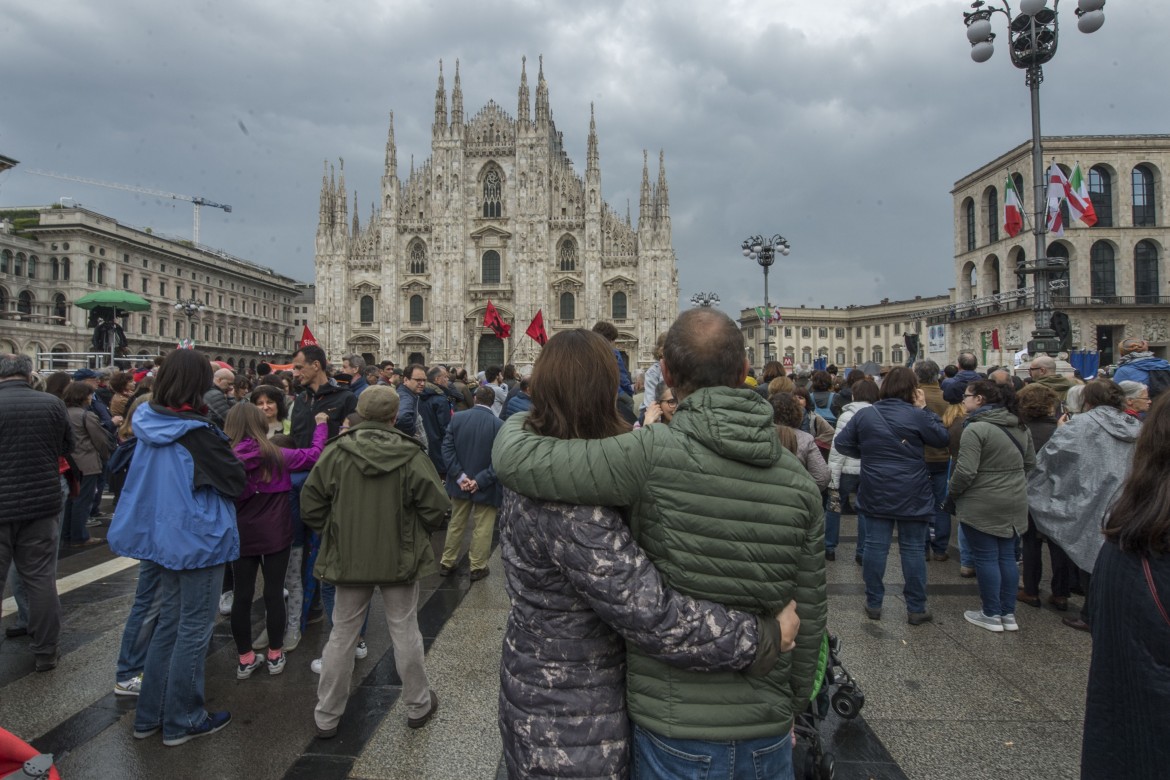Reportage
70,000 march against fascists on Liberation Day
There was the air of a celebration for many of those who attended. No doubt, it was also the right time to put a spotlight on what is happening in the city and what is likely to happen in the future.

The April 25 celebrations started early in Milan, as people in every district of the city went to visit the graves of partisans, men and women, who lost their lives in the struggle to free themselves—and us—from Nazi-Fascist tyranny. The day of commemoration ended late at night, with the concert event organized under the banner “Partigiani in Ogni Quartiere” (“Partisans in every neighborhood”), now in its 12th edition, which was moved to Macao, an indoor venue, because of the bad weather. The day was a national-level event which—despite the rain, bridge traffic stops and provocations—again gathered an impressive number of people.
As always, when those in the first lines of the procession arrived at Piazza Duomo and the speeches from the stage began, the last of those taking part in the enormous march had not even left the starting point. Likewise, as usual, there was much disagreement about the real number of people in attendance. But it matter little whether there were 60,000, 70,000 or 80,000—it’s more important to point out that one could see so many young faces everywhere. This year as well, controversy erupted as pro-Palestinian associations objected to the Jewish Brigade taking part in the march: slogans such as “Zionists, out of the march” and “Israel—terrorist state” were shouted against the members of the brigade, who responded peacefully by singing “Bella Ciao.”
The anti-fascists, men and women, will be under the spotlight for the coming month. That itself can have consequences—in Milan, there was yet more evidence of the fact that the groups of the racist, identitarian and fascist right will not confine themselves to debating ideas. On Wednesday night, the wreath that had been laid near the tombstone of a well-known partisan, Carlo Ciocca, was set on fire.
It is no coincidence that on April 24, before the Milan-Lazio football match, some Roman neo-fascists among Lazio’s supporters, led by the Milanese far-right group Lealtà e Azione, showed up in Piazzale Loreto and unfurled a banner praising Mussolini. Furthermore, also in Milan, on April 29, fascists belonging to many different splinter groups want to march to commemorate some of their “comrades” who died in the ‘70s. Permission for the march has been denied; however, 60 members and parliamentary representatives of the Lega and the Brothers of Italy have sent a letter to the local prefect and superintendent asking that the decision be overturned. Furthermore, it is all too easy to imagine the neo-fascists storming the square regardless.
The demonstrations on Thursday had the air of a celebration for many of those who attended, coming from many different organizations and with many different perspectives. No doubt, it was also the right time to put a spotlight on what is happening in the city and what is likely to happen in the future. On April 29, a march will take place with the slogan “Milan—anti-fascist, anti-racist, diverse and united,” aiming to prevent the Fascists from marching and to honor the memory of Gaetano Amoroso.
The mayor of Milan, Giuseppe Sala, appears to have fully grasped the importance of the moment, for the city and not only. On Thursday, in his very well-received speech from the stage set up in front of the cathedral, he said: “Let us carry with us the living example of the partisans: their work is not done. We will not take even one step back—the values of the Resistance are more alive and more relevant than ever.”
He took up the same theme in even more direct terms on his Facebook page: “Today, just like 74 years ago, Milan is rising up against any attempt to resurrect the dark and ominous times of the past. We are fighting obscurantism with culture, inclusiveness and solidarity: true Milanese values, who have brought prosperity and modernity. Milano is, and shall always remain, a profoundly anti-fascist city. Long live April 25, long live the Resistance, long live freedom!”
Among the many public figures and politicians who took part in the march—among others, Zingaretti, the leader of the Democratic Party, former mayor Pisapia, former President of the Chamber of Deputies Laura Boldrini and the head of Sinistra Italiana, Nicola Fratoianni—one could also see well-known celebrities such as Pif, as well as very many members of the ANPI branch of the Barona district.
The newly elected secretary of the CGIL union, Maurizio Landini, was also there, and spoke out about national politics, attacking those who had tried in recent days to delegitimize the April 25 celebrations, the most beautiful holiday of our calendar: “We should remember the fight against the Mafia, not just today, but it would help if the government were to remember it every single day.
“Everyone should be reminded that the Mafia has existed for 150 years, and collaborated fully with fascism as well. I think it’s dumb to lump together fascism and communism: Fascism was fought by both communism and all the other traditions, and, if we are free now, that is only because freedom was won.”
Originally published at https://ilmanifesto.it/il-lungo-25-aprile-di-milano-in-70mila-sfilano-fino-al-duomo/ on 2019-04-26
